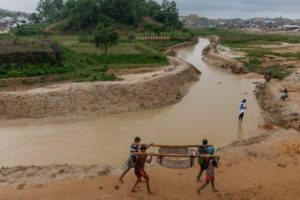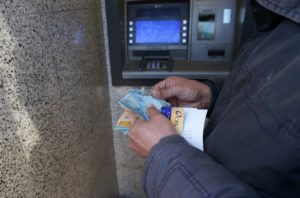When Disaster Strikes, Digital Technology Helps Deliver Improved Aid.
By Tom Price, Independent Writer for ICT4D Conference 2019
 Â Photo credit:Â Ismail Ferdous/CRS
 Photo credit: Ismail Ferdous/CRS
Whether it is assisting refugees fleeing violence or providing aid after a flood or other natural disaster, humanitarian assistance is all about rapid response. To aid those in immediate need, organizations rely on fast access to supplies and information. With resources stretched thin during a crisis, digital technology can literally be a life saver.
Vital information flies thick and fast during an emergency and Jaclene Roshan, Director of Nonprofit Solutions at Salesforce.org, says that one of the most common challenges faced by humanitarian organizations is the inability to see all of their most critical information in a single place. “So many different operations are happening during times of emergency — volunteers are being deployed, inventory is being shipped out, individuals are in need of immediate shelter,“ says Roshan. “And all of these are often managed through different systems, preventing aid workers from being able to access all information related to a single individual or location at once.â€
This is where digital technology comes in. “Salesforce can create a flexible platform that allows for association of various data sets to create a single view of an individual or a program,†says Roshan. This allows decision makers to make fast, informed choices on everything from supplies to shelter allocation in one view.
But what if you are offline? Disasters often occur in the remotest areas. “In areas of little to no connectivity, staff can collect and access data they need offline, and sync it back to their Salesforce system when they’re back online,†explains Roshan.
One of Roshan’s favorite examples of tech use is by the American Red Cross, an organization that responds to a disaster every eight minutes, responding to 60,000 disasters each year. The Red Cross has a Digital Operations Center dedicated to monitoring and staying in touch with the public across social media during disasters. “The innovative center uses Marketing Cloud to listen to social media conversations — gathering invaluable information during a disaster or monitoring public preparedness for a serious situation. Data gathered in the Digital Operations Center can also help determine where to position workers on the ground,†she says.
Another example is Justice Rapid Response (JRR), which helps confront international crimes and serious human rights abuses by rapidly deploying highly-specialized, diverse criminal justice, and human rights professionals to areas in crisis around the world. JRR uses the Salesforce.org Nonprofit Cloud to automate processes and better track a growing roster of experts, missions, and deployments around the world. “The application serves as a repository for all JRR experts, in which each expert is segmented and tagged based on education, employment, language, references, and any other categories used by JRR, allowing administrators to easily locate and engage relevant experts according to specific criteria,†says Roshan.
Roshan also suggests that adding an intelligence layer to processes during an emergency through analytics and AI (artificial intelligence) can drastically improve an NGO’s ability to deliver services with greater efficiency and with more impact. “Imagine opening a dashboard and immediately seeing where aid needs to be directed first or getting an automated recommendation to increase supplies based on pending weather reports,†she says. “The impact AI is having on every single industry is drastically changing the world and bringing this same technology into the hands of humanitarian organizations is a must.â€
Not since World War II has our world seen so many people forced to flee their homes, some 68.5 million according to the United Nations. Norwegian Refugee Council (NRC) is an organization on the front line of protecting refugees and displaced people. People are typically refugees for many years, and in Uganda NRC is using technology to boost programs in education, to make sure lives do not go completely off course.
“I used to teach and I’m excited about the changing face of education through technology,†says Adam Bouloukos, NRC’s Country Director for Uganda. “I am seeing this in the refugee community as well as regular schools.â€
NRC is using tablets in catch-up education classes. In a partnership with War Child Holland, funded by Google.org, refugee children play educational games on tablets to help them learn vital education skills and life lessons like good hygiene.
At the other end of the educational scale, a partnership with Arizona State University (ASU) in the US called “Be A Successful Learner†is preparing 25 South Sudanese refugees and Ugandans from the local host community for higher education. To do this, computer labs and connectivity were set up at Aliyo and Nyumanzi refugee settlement in Adjumani, Uganda. If the students successfully complete online classes in Mathematics, English and Communications they have the opportunity of a place in Ugandan Universities. “We are preparing the refugees to contribute to the Ugandan economy,†says Bouloukos, “and for when they return home.â€
NRC has a commitment to data information and technology to better its programs, but to get maximum benefit Bouloukos advises to be prepared. “You need to think of the small things like storage for the technology, and this can be a challenge in remote areas,†he explains. “There is the training for teachers and staff too. The teachers were as excited as the kids to be using tablets.â€
NRC is a Strategic Partner for the 11th ICT4D Conference which starts on April 30th, in Kampala, Uganda. Like NRC, conference founder Catholic Relief Services (CRS) is also putting technology into the hands of those affected by humanitarian disasters. For Jennifer Poidatz, Vice President of Humanitarian Response at CRS, mobile technology used to mean a bicycle when she was in the Peace Corp. Now digital technology allows her to view data in real time from humanitarian response projects around the world.
 Â Â Photo credit: Maggie Holmesheoran/CRS
  Photo credit: Maggie Holmesheoran/CRS
A digital feedback system was introduced in Egypt, where CRS runs programs to support the refugee community. This has allowed 30,000 people to provide feedback on the services they received. Instead of burdening people with a survey or similar request, the system pulls the feedback from social media and phone hotlines. The information is logged into digital case management files using mobile devices or web-based applications on laptops and desktops.
“This feedback led us to increasing special needs school tuition expenses after we learned that students were not able to cover their fees,†says Poidatz. “We also increased transport allowances for students after metro costs surged in Egypt. Students could afford to travel to classes once more,†she says. In each case, CRS would likely have been unaware of the higher costs faced by the students without this digital suggestion box, and, in turn, CRS successfully approached the donor to cover these increases.
“Every voice deserves to be heard,†says Poidatz. “Information technology such as social media can give a voice to all. We are committed to ensuring the voices of affected persons are not only heard but acted upon.â€